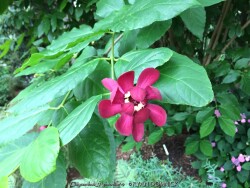

Aphrodite Sweetshrub (Calycanthus x 'Aphrodite') is covered in big, glossy, medium-green leaves. This shrub explodes with enormous cupped flowers that look a bit like a deep red magnolia. They start in early summer with a big flush of flowers continuing to bloom sporadically all summer long. This is a quite large shrub that needs plenty of space to look its best, but if you have the room for it, there are few better ways to use it! 'Aphrodite' is a hybrid between our native Calycanthus and the Asian species, x Sinocalycanthus. You're probably wondering if it's fragrant, and the answer is - it depends. The scent varies based on the age of the bloom, the time of day, and the flower itself. Some people say they smell like pineapple, others apples, others bubblegum, and some get no scent at all. Even if you never sense a whiff off this plant, its fabulous flowers are more than enough reward. Prune after flowering to maintain shape. This Calycanthus performs amazingly well in eastern Kansas landscapes. It is great along a woodland edge or in morning sun. When planted in full shade with rich soil in our Lawrence, KS Zone 6a display garden, growth is very rapid and flowers completely cover the shrub for a few weeks in early summer. Yes, you heard right, this shrub is will flower in full shade. It tolerates a wide variety of soil types including clay but needs prefers well-drained soil high in organic matter. Adaptable to mild drought and heat (plant in full shade in southern zones) but greatly improved with rich, moisture-retentive soils. Typically, our 40 inches of rainfall per year in Eastern Kansas is sufficient. Summer foliage is virtually pest-free. All Proven Winners® plants are legally propagated, healthy and vigorous, true to name, and tagged with color pictures and growing information.
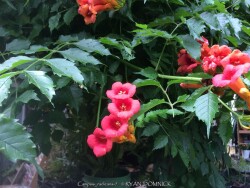

Trumpet vine (Campsis radicans) features shiny dark green foliage, orange-red trumpet-shaped summer flowers, green bean-like seed pods, and gold fall color. Flowers are very attractive to hummingbirds. Trumpet vine is native to the eastern United States including Kansas. Easily grown in a wide variety of soils including heady clay. It is usually grown on pergolas, trellises, and chain-link fences. Beware that this is an extremely vigorous plant that crowds out most weeds and is itself weed-like, with a very spreading growth habit. Best planted and allowed to grow in isolated areas or in horrible soils where no other plant will grow; mowing around it generally stops the yearly spread. Three beautifum mature plants in our display garden grow up posts on the North side of our covered awning behind our shop. They have been thriving for 15 plus years, growing in extremely compacted ab-3 gravel smashed into clay "soil" that is driven on by trucks and constantly walked on. A pick-axe will bounce off with each powerful swing! Now that is a tough "Once it's there, it's there forever" plant!
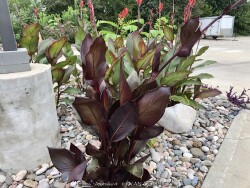

Cannas are typically grown for their continuous summer flowers and vertical wide-leaf foliage. The plants are large tropical and subtropical herbaceous perennials with a rhizomatous rootstock native to areas with a summer monsoon and dry winter. They can be grown as flowering summer patio plants. If growing as a potted plant and trying to overwinter, allowing the foliage to frost is ok, it will not kill the root system. However, do not allow the pot with rootball to freeze solid or go below 20 degrees for more than a few hours; move into a cold garage or basement over the winter with no watering. Cut back and allow to go dormant and place entire pot back out in April or May with a time-release fertilizer. Another more labor intensive way to overwinter cannas is to remove them from the dirt, dust with fungicide, place in box with sawdust, and keep in the refrigerator. We consider this method old-fashioned and too much work but ok if you only want to save a few pieces. If digging from the ground, just save a chunk with the dirt intact and place into a large pot in the garage. During the growing season, fertilize, water regularly, and place in full sun. You may also plant these in the ground for an enormous tropical effect! It is possible to overwinter these in the ground in Kansas by mulching 4-8" thick over deeply planted rhizomes. New growth will usually be slightly delayed but quick to regain full height. In our trial gardens in Lawrence, KS (zone 6a), the following varieties survived after being mulched 6-12" with leaf mulch to -17 degrees F. (Canna 'Daddy's Buckaroo',Canna 'Omega',Canna indica 'Red Stripe',Canna indica 'Ellen's Super Orange', Canna indica 'Wyoming') During the arctic blast of February, 2021, lows down to -17 degrees F on Feb 16th, 2021 were recorded. The longevity of this cold blast was also impressive: 10 days on a row with highs of 10-15 degrees F or lower, 8 nights of lows in the single digits and negatives, and 36 straight hours of 0 degrees F and mostly lower. Canna 'Australia' has maroon leaves and red flowers. This canna can also grow in standing water as a potted plant in water gardens or rain gardens.
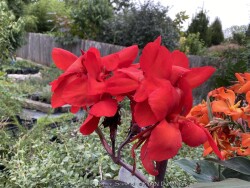

Cannas are typically grown for their continuous summer flowers and vertical wide-leaf foliage. The plants are large tropical and subtropical herbaceous perennials with a rhizomatous rootstock native to areas with a summer monsoon and dry winter. They can be grown as flowering summer patio plants. If growing as a potted plant and trying to overwinter, allowing the foliage to frost is ok, it will not kill the root system. However, do not allow the pot with rootball to freeze solid or go below 20 degrees for more than a few hours; move into a cold garage or basement over the winter with no watering. Cut back and allow to go dormant and place entire pot back out in April or May with a time-release fertilizer. Another more labor intensive way to overwinter cannas is to remove them from the dirt, dust with fungicide, place in box with sawdust, and keep in the refrigerator. We consider this method old-fashioned and too much work but ok if you only want to save a few pieces. If digging from the ground, just save a chunk with the dirt intact and place into a large pot in the garage. During the growing season, fertilize, water regularly, and place in full sun. You may also plant these in the ground for an enormous tropical effect! It is possible to overwinter these in the ground in Kansas by mulching 4-8" thick over deeply planted rhizomes. New growth will usually be slightly delayed but quick to regain full height. In our trial gardens in Lawrence, KS (zone 6a), the following varieties survived after being mulched 6-12" with leaf mulch to -17 degrees F. (Canna 'Daddy's Buckaroo',Canna 'Omega',Canna indica 'Red Stripe',Canna indica 'Ellen's Super Orange', Canna indica 'Wyoming') During the arctic blast of February, 2021, lows down to -17 degrees F on Feb 16th, 2021 were recorded. The longevity of this cold blast was also impressive: 10 days on a row with highs of 10-15 degrees F or lower, 8 nights of lows in the single digits and negatives, and 36 straight hours of 0 degrees F and mostly lower. Canna 'Cannova Bronze Scarlet' is a dwarf variety with reddish leaves and bright red flowers.
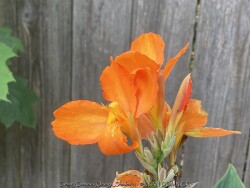

Cannas are typically grown for their continuous summer flowers and vertical wide-leaf foliage. The plants are large tropical and subtropical herbaceous perennials with a rhizomatous rootstock native to areas with a summer monsoon and dry winter. They can be grown as flowering summer patio plants. If growing as a potted plant and trying to overwinter, allowing the foliage to frost is ok, it will not kill the root system. However, do not allow the pot with rootball to freeze solid or go below 20 degrees for more than a few hours; move into a cold garage or basement over the winter with no watering. Cut back and allow to go dormant and place entire pot back out in April or May with a time-release fertilizer. Another more labor intensive way to overwinter cannas is to remove them from the dirt, dust with fungicide, place in box with sawdust, and keep in the refrigerator. We consider this method old-fashioned and too much work but ok if you only want to save a few pieces. If digging from the ground, just save a chunk with the dirt intact and place into a large pot in the garage. During the growing season, fertilize, water regularly, and place in full sun. You may also plant these in the ground for an enormous tropical effect! It is possible to overwinter these in the ground in Kansas by mulching 4-8" thick over deeply planted rhizomes. New growth will usually be slightly delayed but quick to regain full height. In our trial gardens in Lawrence, KS (zone 6a), the following varieties survived after being mulched 6-12" with leaf mulch to -17 degrees F. (Canna 'Daddy's Buckaroo',Canna 'Omega',Canna indica 'Red Stripe',Canna indica 'Ellen's Super Orange', Canna indica 'Wyoming') During the arctic blast of February, 2021, lows down to -17 degrees F on Feb 16th, 2021 were recorded. The longevity of this cold blast was also impressive: 10 days on a row with highs of 10-15 degrees F or lower, 8 nights of lows in the single digits and negatives, and 36 straight hours of 0 degrees F and mostly lower. Canna 'Cannova Orange Shades' is a dwarf variety with green leaves and bright orange flowers.
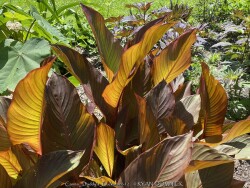

Cannas are typically grown for their continuous summer flowers and vertical wide-leaf foliage. The plants are large tropical and subtropical herbaceous perennials with a rhizomatous rootstock native to areas with a summer monsoon and dry winter. They can be grown as flowering summer patio plants. If growing as a potted plant and trying to overwinter, allowing the foliage to frost is ok, it will not kill the root system. However, do not allow the pot with rootball to freeze solid or go below 20 degrees for more than a few hours; move into a cold garage or basement over the winter with no watering. Cut back and allow to go dormant and place entire pot back out in April or May with a time-release fertilizer. Another more labor intensive way to overwinter cannas is to remove them from the dirt, dust with fungicide, place in box with sawdust, and keep in the refrigerator. We consider this method old-fashioned and too much work but ok if you only want to save a few pieces. If digging from the ground, just save a chunk with the dirt intact and place into a large pot in the garage. During the growing season, fertilize, water regularly, and place in full sun. You may also plant these in the ground for an enormous tropical effect! It is possible to overwinter these in the ground in Kansas by mulching 4-8" thick over deeply planted rhizomes. New growth will usually be slightly delayed but quick to regain full height. In our trial gardens in Lawrence, KS (zone 6a), the following varieties survived after being mulched 6-12" with leaf mulch to -17 degrees F. (Canna 'Daddy's Buckaroo',Canna 'Omega',Canna indica 'Red Stripe',Canna indica 'Ellen's Super Orange', Canna indica 'Wyoming') During the arctic blast of February, 2021, lows down to -17 degrees F on Feb 16th, 2021 were recorded. The longevity of this cold blast was also impressive: 10 days on a row with highs of 10-15 degrees F or lower, 8 nights of lows in the single digits and negatives, and 36 straight hours of 0 degrees F and mostly lower. Canna 'Daddy's Buckaroo' is a tall variety with reddish-green leaves and red-orange flowers. This variety is among the most cold hardy of the cannas due to its vigorous deep growing rhizomes. Our original plant came from Brian's Botanicals mail-order nursery in Kentucky.
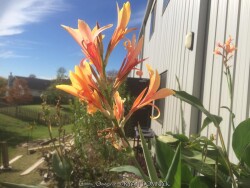

Cannas are typically grown for their continuous summer flowers and vertical wide-leaf foliage. The plants are large tropical and subtropical herbaceous perennials with a rhizomatous rootstock native to areas with a summer monsoon and dry winter. They can be grown as flowering summer patio plants. If growing as a potted plant and trying to overwinter, allowing the foliage to frost is ok, it will not kill the root system. However, do not allow the pot with rootball to freeze solid or go below 20 degrees for more than a few hours; move into a cold garage or basement over the winter with no watering. Cut back and allow to go dormant and place entire pot back out in April or May with a time-release fertilizer. Another more labor intensive way to overwinter cannas is to remove them from the dirt, dust with fungicide, place in box with sawdust, and keep in the refrigerator. We consider this method old-fashioned and too much work but ok if you only want to save a few pieces. If digging from the ground, just save a chunk with the dirt intact and place into a large pot in the garage. During the growing season, fertilize, water regularly, and place in full sun. You may also plant these in the ground for an enormous tropical effect! It is possible to overwinter these in the ground in Kansas by mulching 4-8" thick over deeply planted rhizomes. New growth will usually be slightly delayed but quick to regain full height. In our trial gardens in Lawrence, KS (zone 6a), the following varieties survived after being mulched 6-12" with leaf mulch to -17 degrees F. (Canna 'Daddy's Buckaroo',Canna 'Omega',Canna indica 'Red Stripe',Canna indica 'Ellen's Super Orange', Canna indica 'Wyoming') During the arctic blast of February, 2021, lows down to -17 degrees F on Feb 16th, 2021 were recorded. The longevity of this cold blast was also impressive: 10 days on a row with highs of 10-15 degrees F or lower, 8 nights of lows in the single digits and negatives, and 36 straight hours of 0 degrees F and mostly lower. Canna 'Omega' is a tall variety with blue-green leaves and orange flowers. This variety is the most cold hardy of the cannas due to its vigorous deep growing rhizomes. The rate of spread is faster so provide a larger space for this plant. This canna can also grow in standing water as a potted plant in water gardens or rain gardens.
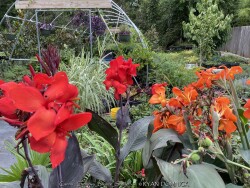

Cannas are typically grown for their continuous summer flowers and vertical wide-leaf foliage. The plants are large tropical and subtropical herbaceous perennials with a rhizomatous rootstock native to areas with a summer monsoon and dry winter. They can be grown as flowering summer patio plants. If growing as a potted plant and trying to overwinter, allowing the foliage to frost is ok, it will not kill the root system. However, do not allow the pot with rootball to freeze solid or go below 20 degrees for more than a few hours; move into a cold garage or basement over the winter with no watering. Cut back and allow to go dormant and place entire pot back out in April or May with a time-release fertilizer. Another more labor intensive way to overwinter cannas is to remove them from the dirt, dust with fungicide, place in box with sawdust, and keep in the refrigerator. We consider this method old-fashioned and too much work but ok if you only want to save a few pieces. If digging from the ground, just save a chunk with the dirt intact and place into a large pot in the garage. During the growing season, fertilize, water regularly, and place in full sun. You may also plant these in the ground for an enormous tropical effect! It is possible to overwinter these in the ground in Kansas by mulching 4-8" thick over deeply planted rhizomes. New growth will usually be slightly delayed but quick to regain full height. In our trial gardens in Lawrence, KS (zone 6a), the following varieties survived after being mulched 6-12" with leaf mulch to -17 degrees F. (Canna 'Daddy's Buckaroo',Canna 'Omega',Canna indica 'Red Stripe',Canna indica 'Ellen's Super Orange', Canna indica 'Wyoming') During the arctic blast of February, 2021, lows down to -17 degrees F on Feb 16th, 2021 were recorded. The longevity of this cold blast was also impressive: 10 days on a row with highs of 10-15 degrees F or lower, 8 nights of lows in the single digits and negatives, and 36 straight hours of 0 degrees F and mostly lower.
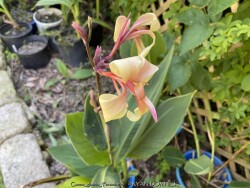

Cannas are typically grown for their continuous summer flowers and vertical wide-leaf foliage. The plants are large tropical and subtropical herbaceous perennials with a rhizomatous rootstock native to areas with a summer monsoon and dry winter. They can be grown as flowering summer patio plants. If growing as a potted plant and trying to overwinter, allowing the foliage to frost is ok, it will not kill the root system. However, do not allow the pot with rootball to freeze solid or go below 20 degrees for more than a few hours; move into a cold garage or basement over the winter with no watering. Cut back and allow to go dormant and place entire pot back out in April or May with a time-release fertilizer. Another more labor intensive way to overwinter cannas is to remove them from the dirt, dust with fungicide, place in box with sawdust, and keep in the refrigerator. We consider this method old-fashioned and too much work but ok if you only want to save a few pieces. If digging from the ground, just save a chunk with the dirt intact and place into a large pot in the garage. During the growing season, fertilize, water regularly, and place in full sun. You may also plant these in the ground for an enormous tropical effect! It is possible to overwinter these in the ground in Kansas by mulching 4-8" thick over deeply planted rhizomes. New growth will usually be slightly delayed but quick to regain full height. In our trial gardens in Lawrence, KS (zone 6a), the following varieties survived after being mulched 6-12" with leaf mulch to -17 degrees F. (Canna 'Daddy's Buckaroo',Canna 'Omega',Canna indica 'Red Stripe',Canna indica 'Ellen's Super Orange', Canna indica 'Wyoming') During the arctic blast of February, 2021, lows down to -17 degrees F on Feb 16th, 2021 were recorded. The longevity of this cold blast was also impressive: 10 days on a row with highs of 10-15 degrees F or lower, 8 nights of lows in the single digits and negatives, and 36 straight hours of 0 degrees F and mostly lower. Canna glauca 'Panache' is a native canna to South-east U.S. with blue-green leaves and salmon-pink to peach flowers. This canna can also grow in standing water as a potted plant or in a rain garden.
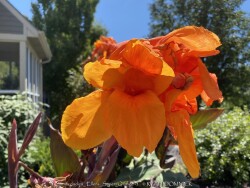

Cannas are typically grown for their continuous summer flowers and vertical wide-leaf foliage. The plants are large tropical and subtropical herbaceous perennials with a rhizomatous rootstock native to areas with a summer monsoon and dry winter. They can be grown as flowering summer patio plants. If growing as a potted plant and trying to overwinter, allowing the foliage to frost is ok, it will not kill the root system. However, do not allow the pot with rootball to freeze solid or go below 20 degrees for more than a few hours; move into a cold garage or basement over the winter with no watering. Cut back and allow to go dormant and place entire pot back out in April or May with a time-release fertilizer. Another more labor intensive way to overwinter cannas is to remove them from the dirt, dust with fungicide, place in box with sawdust, and keep in the refrigerator. We consider this method old-fashioned and too much work but ok if you only want to save a few pieces. If digging from the ground, just save a chunk with the dirt intact and place into a large pot in the garage. During the growing season, fertilize, water regularly, and place in full sun. You may also plant these in the ground for an enormous tropical effect! It is possible to overwinter these in the ground in Kansas by mulching 4-8" thick over deeply planted rhizomes. New growth will usually be slightly delayed but quick to regain full height. In our trial gardens in Lawrence, KS (zone 6a), the following varieties survived after being mulched 6-12" with leaf mulch to -17 degrees F. (Canna 'Daddy's Buckaroo',Canna 'Omega',Canna indica 'Red Stripe',Canna indica 'Ellen's Super Orange', Canna indica 'Wyoming') During the arctic blast of February, 2021, lows down to -17 degrees F on Feb 16th, 2021 were recorded. The longevity of this cold blast was also impressive: 10 days on a row with highs of 10-15 degrees F or lower, 8 nights of lows in the single digits and negatives, and 36 straight hours of 0 degrees F and mostly lower. Canna indica 'Ellen's Super Orange' is a tall variety with reddish-green leaves and bright orange flowers. This variety is among the most cold hardy of the cannas due to its vigorous deep growing rhizomes. Our original plant came from a residential garden in Lawrence, KS.
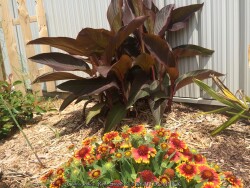

Cannas are typically grown for their continuous summer flowers and vertical wide-leaf foliage. The plants are large tropical and subtropical herbaceous perennials with a rhizomatous rootstock native to areas with a summer monsoon and dry winter. They can be grown as flowering summer patio plants. If growing as a potted plant and trying to overwinter, allowing the foliage to frost is ok, it will not kill the root system. However, do not allow the pot with rootball to freeze solid or go below 20 degrees for more than a few hours; move into a cold garage or basement over the winter with no watering. Cut back and allow to go dormant and place entire pot back out in April or May with a time-release fertilizer. Another more labor intensive way to overwinter cannas is to remove them from the dirt, dust with fungicide, place in box with sawdust, and keep in the refrigerator. We consider this method old-fashioned and too much work but ok if you only want to save a few pieces. If digging from the ground, just save a chunk with the dirt intact and place into a large pot in the garage. During the growing season, fertilize, water regularly, and place in full sun. You may also plant these in the ground for an enormous tropical effect! It is possible to overwinter these in the ground in Kansas by mulching 4-8" thick over deeply planted rhizomes. New growth will usually be slightly delayed but quick to regain full height. In our trial gardens in Lawrence, KS (zone 6a), the following varieties survived after being mulched 6-12" with leaf mulch to -17 degrees F. (Canna 'Daddy's Buckaroo',Canna 'Omega',Canna indica 'Red Stripe',Canna indica 'Ellen's Super Orange', Canna indica 'Wyoming') During the arctic blast of February, 2021, lows down to -17 degrees F on Feb 16th, 2021 were recorded. The longevity of this cold blast was also impressive: 10 days on a row with highs of 10-15 degrees F or lower, 8 nights of lows in the single digits and negatives, and 36 straight hours of 0 degrees F and mostly lower. Canna indica 'Red Stripe' is a medium variety with reddish-green leaves and red flowers.
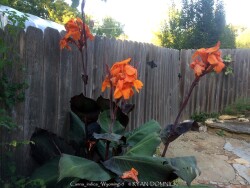

Cannas are typically grown for their continuous summer flowers and vertical wide-leaf foliage. The plants are large tropical and subtropical herbaceous perennials with a rhizomatous rootstock native to areas with a summer monsoon and dry winter. They can be grown as flowering summer patio plants. If growing as a potted plant and trying to overwinter, allowing the foliage to frost is ok, it will not kill the root system. However, do not allow the pot with rootball to freeze solid or go below 20 degrees for more than a few hours; move into a cold garage or basement over the winter with no watering. Cut back and allow to go dormant and place entire pot back out in April or May with a time-release fertilizer. Another more labor intensive way to overwinter cannas is to remove them from the dirt, dust with fungicide, place in box with sawdust, and keep in the refrigerator. We consider this method old-fashioned and too much work but ok if you only want to save a few pieces. If digging from the ground, just save a chunk with the dirt intact and place into a large pot in the garage. During the growing season, fertilize, water regularly, and place in full sun. You may also plant these in the ground for an enormous tropical effect! It is possible to overwinter these in the ground in Kansas by mulching 4-8" thick over deeply planted rhizomes. New growth will usually be slightly delayed but quick to regain full height. In our trial gardens in Lawrence, KS (zone 6a), the following varieties survived after being mulched 6-12" with leaf mulch to -17 degrees F. (Canna 'Daddy's Buckaroo',Canna 'Omega',Canna indica 'Red Stripe',Canna indica 'Ellen's Super Orange', Canna indica 'Wyoming') During the arctic blast of February, 2021, lows down to -17 degrees F on Feb 16th, 2021 were recorded. The longevity of this cold blast was also impressive: 10 days on a row with highs of 10-15 degrees F or lower, 8 nights of lows in the single digits and negatives, and 36 straight hours of 0 degrees F and mostly lower. Canna indica 'Wyoming' is a medium variety with reddish-green leaves and bright orange flowers.
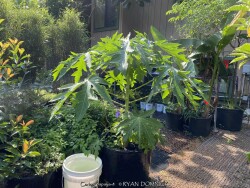

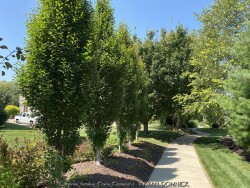

***Tree descriptions available with future update!***
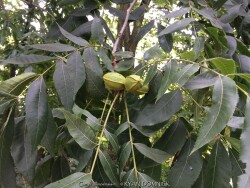

***Tree descriptions available with future update!***
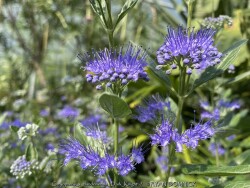

Dark Knight Caryopteris (Caryopteris x clandonensis 'Dark Knight') features darker green summer foliage followed by late-summer deep blue flowers and a compact growing habit. It adds much-needed color to the late summer landscape and makes a handsome companion with perennials. A great favorite with pollinators of all types (bees, butterflies, and hummingbirds) in the late season garden. Caryopteris demands a sunny spot and very well-drained soil. Wet soils, particularly those that remain soggy during periods of cold weather, will cause root rot. For this reason, we recommend early season planting of caryopteris in zones 5. In Eastern Kansas, this cultivar performs WELL with just about everything nature has to challenge it! Heat and drought are tolerated well. Cold tolerance is no problem for us in zone 6. Caryopteris gives great winter interest with it's dried flowers. The only maintenance this shrub needs is cutting back about 1/2 way in early spring before new growth emerges. No disease or pest problems. Great plant for berms or hot West or South exposures in full sun. Do not plant in rich moist soils or root rot will probably occur. Even when not blooming, the compact green foliage looks good on it's own or combines well with earlier season blooming red, purple, blue, or magenta flowering plants. Combine with crapemyrtles and butterflybush to create a late season "all you can eat" buffet for pollinators!
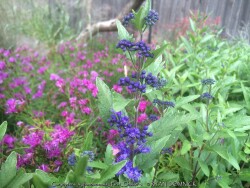

First Choice Caryopteris (Caryopteris x clandonensis 'First Choice') blooms earlier than other earlier caryopteris. This shrub develops a compact, tight habit with dark green foliage and deep blue long-lasting flowers. In Eastern Kansas, this cultivar performs WELL with just about everything nature has to challenge it! Heat and drought are tolerated well. Cold tolerance is no problem for us in zone 6. Caryopteris gives great winter interest with it's dried flowers. The only maintenance this shrub needs is cutting back about 1/2 way in early spring before new growth emerges. No disease or pest problems. Great plant for berms or hot West or South exposures in full sun. Do not plant in rich moist soils or root rot will probably occur. Even when not blooming, the compact green foliage looks good on it's own or combines well with earlier season blooming red, purple, blue, or magenta flowering plants. Combine with crape myrtles and butterfly bush to create a late season "all you can eat" buffet for pollinators!
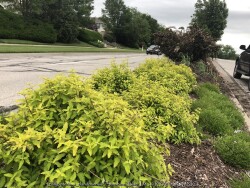

Sunshine Blue® II Bluebeard (Caryopteris x clandonensis 'Sunshine Blue II') is the hardiest caryopteris yet! Sunshine Blue II is a new, improved variety of the classic Sunshine Blue, but it's much more tolerant of cold climates. If you've had trouble with bluebeard surviving winter in your area in the past, now's your chance to enjoy the vivid gold foliage and blue blooms of this late blooming favorite. An excellent plant for attracting pollinators! Top reasons to grow Sunshine Blue II caryopteris: 1.The hardiest caryopteris yet - survives winter even in the Midwest. 2.Colorful all season, especially late in summer when blue flowers appear. 3.Thrives in hot, dry, sunny spots. Maintenance Notes: Plant bluebeard in full sun and well-drained soil. Though Sunshine Blue II tolerates colder conditions than other caryopteris, it will do best if you avoid planting it in spots where the soil is cold or wet in winter and early spring. Cut back hard in spring, after the new growth emerges. Avoid late season planting in coldest parts of its hardiness range. In Eastern Kansas, this cultivar performs WELL with just about everything nature has to challenge it! Heat and drought are tolerated well. Cold tolerance is no problem for us in zone 6. Caryopteris gives great winter interest with it's dried flowers. The only maintenance this shrub needs is cutting back about 1/2 way in early spring before new growth emerges. No disease or pest problems. Great plant for berms or hot West or South exposures in full sun. Do not plant in rich moist soils or root rot will probably occur. Even when not blooming, the intense gold foliage looks good on it's own or combines well with earlier season blooming red, purple, blue, or magenta flowering plants. Combine with crapemyrtles and butterflybush to create a late season "all you can eat" buffet for pollinators! All Proven Winners® plants are legally propagated, healthy and vigorous, true to name, and tagged with color pictures and growing information.
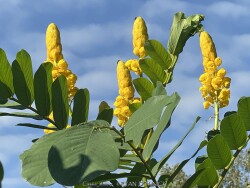

Yellow Candlestick Tree (Cassia / Senna alata) is grown in Kansas as a giant annual capable of reaching 6 to 12 feet in one season. Growth is slow at first in Spring when temperatures are still cool. It is native to tropical rainforests in Mexico and South America generally fulfilling the role of a pioneer species rapidly colonizing disturbed areas. Bright green bi-pinnate leaves are symmetrically arranged and very tropical looking. As branching and growth form develop, the overall geometrical effect is stunning even without flowers yet. Finally by September and all through October until frost, yellow candle-like flowers tower over the foliage. Some plants may have up to 50-100 flower spikes at one time. Cut down promptly after frost as there is no winter interest. Seeds rarely have time to develop in our shorter growing season but it is possible to harvest seeds if the first fall freeze is late. Yellow Candlestick Tree grows fastest in rich well drained soils and plenty of water. Growth is equally impressive in most Kansas soils including heavy clay as long as watering is sufficient. Yellow Candlestick Tree needs hot summers, full sun, and warm humid conditions to thrive. When grown in a large pot, it is very difficult to overwinter inside so it's best to buy new plants each year. This plant has also evolved and interesting relationship with ants, providing nectary glands (food) in exchange for protection from insect pests. Use Yellow Candlestick Tree where you need to fill up a lot of space in a hurry or just like lots of yellow flowers in the fall when other things are not blooming. Interestingly, the foliage is sensitive to light, folding up neatly at sunset and opening up the nest morning.
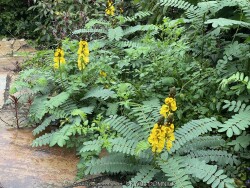

***Description for this plant available with future update!***
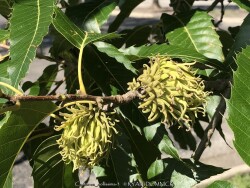

***Tree descriptions available with future update!***
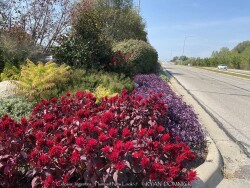

***Description for this plant available with future update!***
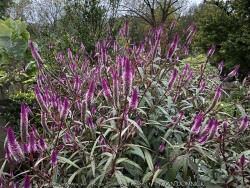

Flamingo Feather Celosia (Celosia argentea var. spicata 'Flamingo Feather') is a large magenta flowering annual. Growth starts off in May when temperatures have warmed. Beautiful dark green foliage has reddish colored back sides of the leaf and magenta stems. After achieving about 3 to 4 feet in height and wide, fuzzy magenta flower spikes begin to appear usually by July. Ultimate height can reach 5-6 feet as flowering becomes more dense and continues until frost providing an excellent long-lasting show. Celosia has little winter interests so you may cut down promptly after the first fall freeze. This is a time to save some of the seeds if you wish to sprinkle them in a new area next year. You may or may not enjoy the fact that the Celosia will easily re-seed itself in areas that you do not mulch. Seedlings come up rather late and can create a carpet under the previous years planting location. We usually allow self-seeding to occur in our display garden in select areas and then spray Roundup or mulch wherever you do not want seedlings. Flamingo Feather Celosia needs full sun for best flowering but tolerated virtually any soil conditions including compacted driveway gravel. Use Flamingo Feather Celosia where you need to fill up a lot of space in a hurry or just like lots of magenta flowers in the fall when other things are not blooming. Celosia is also grown as a food crop in Africa and Southeast Asia.
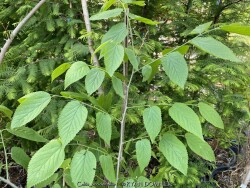

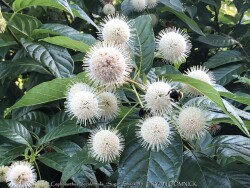

Button bush (Cephalanthus occidentalis) is a beautiful rounded shrub with glossy green leaves that turn reddish maroon in fall. White flowers are very unique (and look like a coronavirus) consisting of small spheres with protruding anthers. Bloom occurs all summer and are attractive to many different bee and butterfly species, including the swallowtail butterfly. Red fruiting heads appear in late summer adding to the ornamental appeal! In its native habitat covering most of Eastern United States including disjunct populations in Arizona, California, and Mexico, this wetland shrub can be found in low-lying areas. This includes swamps, marshes, bogs, wetlands, and along the edges of ponds, streams, and rivers. In Eastern Kansas, this is a no-brainer shrub to small tree for average garden soils including heavy clay and useful for rain gardens. Adapts to a wide range of soils except dry ones if in poor soils. Tolerant of moderate drought once established especially if in moisture-retentive rich soils. As a testament to this plants survivability, Clinton Lake and Perry Lake located in NE kansas flooded in 2020 with areas of shore-line underwater for the entire growing season. This killed every other plant species was killed except for buttonbush: all top growth was killed but new shoots from the root systems of thousands of plants along the shore resumed the following year when water receded. Basically, these plants survived over 18 months with no growth from fall of 2019 to spring of 2021. This plant can also grow in permanent standing water or as a potted plant in water gardens. Sugar Shack® Buttonbush (Cephalanthus occidentalis 'Sugar Shack') in a new Proven Winners variety! Although buttonbush has long been prized as a native and great for rain gardens, it was way too big for most landscapes. Not anymore! They cut the size in half and added improved colorful red fruit and glossy foliage. Add in cool looking, fragrant white flowers and you've got a delightful plant that shines from spring to fall. Blooming on new wood, button bush may be trimmed in early spring. Complete rejuvenation may also be done if plants get too big.
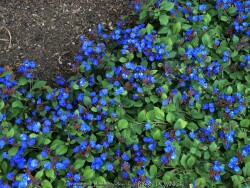

Creeping Plumbago / Leadwort (Ceratostigma plumbaginoides) is a Chinese native plant well adapted to our climate without being invasive in Kansas. It features nonstop royal blue flowers from midsummer till hard freeze; Usually three months or more. After a first light freeze, if flowering is still occurring, rich green foliage will turn bright red while still containing a few blue flowers. This creates a one-of-a-kind contrast not seen in any other plants. Plumbago combines well with just about any other plant due to its rare flower color. This is especially dramatic is combining it with opposites on the color wheel like orange, red or yellow. Growth is often slow to emerge in the spring as plumbago needs warmer soil than most other plants to start growing. This allows for a good combination for spring bulbs to grow with plumbago coming up later to hide the dying bulb foliage. In Kansas landscapes, plumbago is often used as a full sun groundcover in hot areas such as west or south side of the house. Normal garden conditions and berms are fine as well. Plants can survive and flower in shade but growth will be much slower and risk of death will be present until established. In zone 6a, all plantings should be mulched and only larger size established pots should be planted if in the fall. Plumbago sold in flats of many smaller plants can safely be planted in spring or summer. Plumbago needs medium to dry soil tolerating clay as long as everything as well-drained. Once plants are established for a season or two in full sun, they are nearly indestructible. Slow spread will occur and plants will develop very high density smothering out weeds. Sometimes the slowly spreading growth (underground rhizones) can be a problem after a decade or so. However, if you plan ahead and use it as a groundcover like intended, it will be perfect. Being a very low maintenance plant not requiring extra watering or deadheading, the only thing you need to do is weed-eat or cut back all the foliage in the winter. Plumbago has no pest or disease problems.
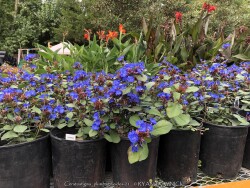

Creeping Plumbago / Leadwort (Ceratostigma plumbaginoides) is a Chinese native plant well adapted to our climate without being invasive in Kansas. It features nonstop royal blue flowers from midsummer till hard freeze; Usually three months or more. After a first light freeze, if flowering is still occurring, rich green foliage will turn bright red while still containing a few blue flowers. This creates a one-of-a-kind contrast not seen in any other plants. Plumbago combines well with just about any other plant due to its rare flower color. This is especially dramatic is combining it with opposites on the color wheel like orange, red or yellow. Growth is often slow to emerge in the spring as plumbago needs warmer soil than most other plants to start growing. This allows for a good combination for spring bulbs to grow with plumbago coming up later to hide the dying bulb foliage. In Kansas landscapes, plumbago is often used as a full sun groundcover in hot areas such as west or south side of the house. Normal garden conditions and berms are fine as well. Plants can survive and flower in shade but growth will be much slower and risk of death will be present until established. In zone 6a, all plantings should be mulched and only larger size established pots should be planted if in the fall. Plumbago sold in flats of many smaller plants can safely be planted in spring or summer. Plumbago needs medium to dry soil tolerating clay as long as everything as well-drained. Once plants are established for a season or two in full sun, they are nearly indestructible. Slow spread will occur and plants will develop very high density smothering out weeds. Sometimes the slowly spreading growth (underground rhizones) can be a problem after a decade or so. However, if you plan ahead and use it as a groundcover like intended, it will be perfect. Being a very low maintenance plant not requiring extra watering or deadheading, the only thing you need to do is weed-eat or cut back all the foliage in the winter. Plumbago has no pest or disease problems.


***Tree descriptions available with future update!***
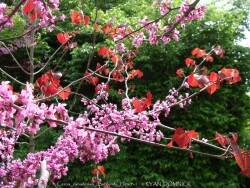

Cercis canadensis Burgundy Hearts® is an improved reddish purple-leaf variety developed by Greenleaf Nurseries in Oklahoma. Burgundy Hearts more drought and heat tolerant. Pinkish-lavender April flowers bloom for about a month before leaves appear. It has a more or less rounded form, wider than it is tall. This small deciduous tree is known for its heart-shaped leaves that hold their dark color longer in the summer, taking on reddish wine tones towards the fall. Many of the problems with the regular species redbud tree are not an issue with this improved cultivar. It is to be expected however that all Redbuds have a relatively short lifespan of 20-40 years but even so, are worth planting for its beautiful flowers. It is not weak wooded and makes a nice hot non-sparking firewood. The short life span is not due to breakage so much as it is to the tree's susceptibility to heart-rot especially when branch crotches form and get older. Other problems include canker, verticillium wilt and root rot. Most redbud varieties thrive in full sun to partial shade. They will tolerate full shade but become elongated and thin as they reach for the sun. Redbuds do well in most soil types but adequate drainage is a must; it can tolerate dry shade of Eastern Kansas forests receiving at least 35" of rainfall per year. The species is a native from southern Canada to Florida, east to Kansas. The regular species also has the potential to self seed in your yard but not Burgundy Hearts. As a dwarf tree, use 'Merlot' as a specimen or part of a group. It reaches about 20 to 30 feet high and wide in full sun. Reddish leaf color emerges in the spring and is maintained all summer long if in mostly full sun. The color of older purple redbuds (like Forest Pansy) fades to dark green as the summer heat intensifies.
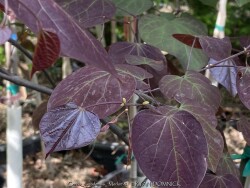

This purple-leaf Redbud (Cercis canadensis 'Merlot') is a canadensis and texensis cross to produce a more drought and heat tolerant tree. It has glossy, small rounded dark purple leaves and has an upright vase-shaped growth habit. This small deciduous tree is known for its stunning display of colorful blooms a deep magenta color. Many of the problems with the regular species redbud tree are not an issue with this improved cultivar. It is to be expected however that all Redbuds have a relatively short lifespan of 20-40 years but even so, are worth planting for its beautiful flowers. It is not weak wooded and makes a nice hot non-sparking firewood. The short life span is not due to breakage so much as it is to the tree's susceptibility to heart-rot especially when branch crotches form and get older. Other problems include canker, verticillium wilt and root rot. Most redbud varieties thrive in full sun to partial shade. They will tolerate full shade but become elongated and thin as they reach for the sun. Redbuds do well in most soil types but adequate drainage is a must; it can tolerate dry shade of Eastern Kansas forests receiving at least 35" of rainfall per year. The species is a native from southern Canada to Florida, east to Kansas. The regular species also has the potential to self seed in your yard but not 'Merlot'. As a dwarf tree, use 'Merlot' as a specimen or part of a group. It reaches about 12 to 15 feet high and wide in full sun. Reddish leaf color emerges in the spring and is maintained all summer long if in mostly full sun. The color of older purple redbuds (like Forest Pansy) fades to dark green as the summer heat intensifies.
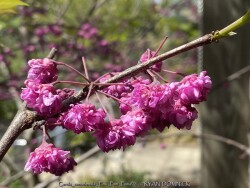

***Tree descriptions available with future update!*** Hybrid of Oklahoma Redbud
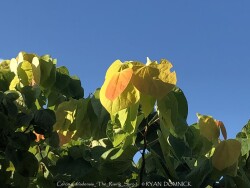

***Tree descriptions available with future update!***
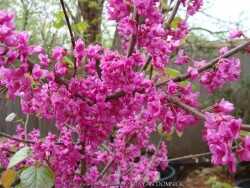

***Tree descriptions available with future update!***
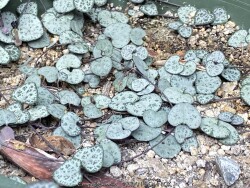

Ceropegia woodii known as the Rosary Vine and String of Hearts. This unusual, hardy vining succulent produces pretty, variegated, heart-shaped leaves with purple undersides on tough, wire-like stems. They are usually grown as a patio or house plant in Kansas. String of Hearts also grow well in hanging baskets as a durable, succulent plant able to survive drying out, heat and dry air like few others! If conditions get too rough, the foliage simply dies back and growth returns from underground tubers when favorable conditions return. To play is safe, potted plants are best moved in before night temperatures get below 45 degrees F. It is important to avoid the combination of wet and cold. Before extreme cold occurs, move to a bright interior window over the winter with no watering and keep above freezing. As a winter house plant, it will look presentable all winter long with just no waterings. As a permanent house plant, provide bright light and allow the soil to dry between waterings for many years of carefree enjoyment. Plants grown permanently indoors may begin to elongate stretching for light producing weak new growth. It can be hard to reproduce the intense UV sunlight they need so moving outside for the summer is best. Generally if moving outside for the summer, allow 1-2 weeks of part shade or morning sun before placing in full sun. Plants with time to acclimate will thrive in full sun but be careful not to rush it or sunburning will occur. Potted plants are very low maintenance. I have never seen any insect problems on this plant.
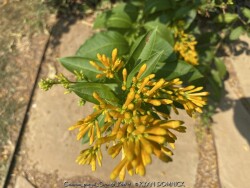

***Description for this plant available with future update!***


Gold Mop False Cypress (Chamaecyparis pisifera 'Gold Mop') is from a group of small coniferous shrubs from Asia with Juniper-like foliage. The foliage is bright yellow, thread-like and creates a relatively low, semi-weeping habit. It provides consistent color during spring, summer, fall, and darkens to a more gold color by winter providing excellent color when most other plants are dormant. Full sun and average garden conditions are preferred. Maintenance is pretty easy, only prune when needed to control size. Do not prune in late summer or fall. Coloring is definitely best if the plant can receive winter sun. Combine in the summer with other flowering perennials and shrubs. Combine in the winter with ornamental grasses, yuccas, Nandinas, or winter interest plants that contrast with gold.
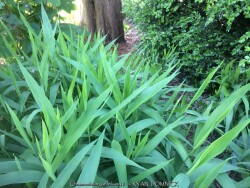

Northern / Inland Sea Oats (Chasmanthium latifolium) is a grass native to the central and eastern United States including some areas in the southwest. Sea Oats is grown is notable for its large graceful seedheads and ability to tolerate full shade. Sending up blue-green spools of basal leaves in spring, it will grow to 2 feet tall with green seed heads starting to form earlier than most other grasses. As it turns a vivid green by June, the translucent green seedheads swaying in the breeze. By mid-summer, the seeds will have turned an attractive ivory and will turn brown in a few months before dropping off in fall. It looks attractive into late fall but becomes tattered after seeds drop making it a good grass to cut back in the late fall or early winter instead of Spring. For the home garden in rich well irrigated areas, this species can be too aggressive from self-seeding to mix with other plants. Use as a mass planting in any shaded area allowing extra room. However, in a difficult dry-shade garden, it will thrive, flower, and be relatively tame without much spread. Mulch will also stop self-seeding. It is one of the few plants that can survive under an established Silver Maple! Now if you need a plant to prevent soil erosion along streams, use this reseeding to your advantage! As it reseeds easily and can expand aggressively within a couple of years, it makes a solid root mat in moist erosion-prone loam soils.
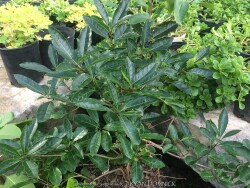

Fringe Tree, is also known as Chionanthus virginicus
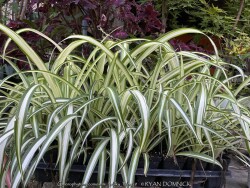

Milky Way Spider Plant (Tropical), is also known as Chlorophytum comosum 'Milky Way'
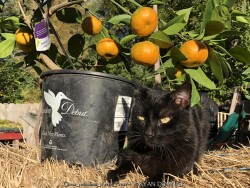

Arctic Frost Hardy Satsuma (Citrus reticulata 'Arctic Frost') is typically grown in warmer zones as far North as Dallas (Zone 8a). Along with other tropicals and succulents in Kansas, Arctic Frost is usually grown as summer patio plant and then moved inside for the winter. Move to bright area in a cold garage, basement, or window over the winter with monthly watering. During the growing season, water regularly and place in full sun. If grown in a larger 20 gallon pot or so, it may flower and fruit when 4-5 feet tall after a few years. Before hard freezes come in the fall, move inside to protect from temperatures below 25 degrees F if you want fruit. Flower buds form in the winter on citrus trees. If you want evergreen foliage, protect with anything lower than 15 degrees F. It will tolerate down to 10 degrees F with complete defoliation and around 0 degrees F with complete wood kill down to the base of the trunk. Because it is grown on its own root system, it will come back true from winter kill down to the ground. A plant in our Lawrence, KS cold frame survived 0 degrees F for a few days and grew 3-4' back the following year. Don't expect flowers and fruit in these conditions though.
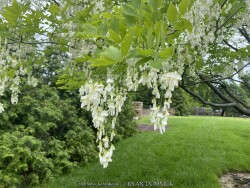



***Description for this plant available with future update!***
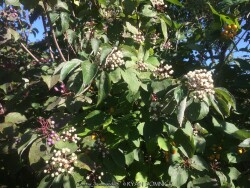

Rough-leaf dogwood is a suckering shrub or rarely a small tree to 15 ft. It is native woodland edges and tall-grass prairie ravines in Kansas olong with the Great Plains and Midwestern regions of the United States. This dogwood is easily recognized by the rough, upper leaf surfaces with flat-topped clusters of creamy-yellow flowers and white fruit on reddish brown or gray twigs. Fall color is purplish-red. Cream-white flowers about 1/4 inch wide, with 4 petals characteristic of all dogwoods. Numerous flowers are in broad clusters at the ends of branches, appearing from April to early June. White fruit then appears in late summer and early fall. A favorite of many wild birds, the fruit is usually stripped clean within a couple weeks. It spreads from root sprouts and provides cover for wildlife and erosion control along ditches. Other uses of roughleaf dogwood include buffer strip around parking lots, highway medians, dust screens along country roads, and naturalizing. It will grow in full sun or full shade in medium to dry soils including dry-shade. However, fall color is quite a bit reduced in full shade. Because of its tolerance for adverse conditions including poor soil and rock, it is often one of the last resort plants that will survive in certain areas. For the home garden, the species is generally too aggressive to mix with other plants especially when irrigated and growing in rich soil. However, in a difficult dry-shade garden, it will thrive, flower, and be relatively tame with little spreading.
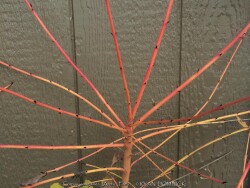

Arctic Sun® Dogwood (Cornus sanguinea 'Arctic Sun') is a new color breakthrough from Proven Winners! Set your winter landscape ablaze with color! Keep your landscape lively even in winter with the glorious yellow, orange, and coral stems of Arctic Sun® dogwood. It performs like the familiar red-twig dogwoods but with unique color that positively glows in the landscape. Tolerant of a very wide range of soil conditions and one of the best ornamental shrubs for shade, Arctic Sun dogwood is an easy choice for nearly effortless color. Top reasons to grow Arctic Sun dogwood: 1.unusual yellow, orange, and coral stems pop in the winter landscape. 2.easy to grow. 3.deer resistant and shade tolerant. Uses Notes: Beautiful in the landscape or a container to add winter interest. Stems may be cut for winter flower arrangements. Maintenance Notes: The best red color appears on one and two year old stems; older stems will turn corky and brown. To maintain a colorful display, you can do one of two things: one, cut the whole plant back to short stubs every other year. Two, cut out one-third of the oldest stems every year. This option is recommended if you planted your Arctic Fire® dogwood to provide coverage. Early spring is the best time to prune. If desired, apply a granular fertilizer formulated for trees and shrubs at pruning time. In Eastern Kansas, this cultivar performs WELL with just about everything nature has to challenge it! Heat and drought are tolerated if in shade or morning sun. Cold tolerance is no problem. No disease or pest problems. Great plant for dry-shade. After 10 years and despite a slow growth rate, it is advisable to rejuvinate this shrub down to the ground as it will reach 5-6 feet tall eventually. Especially effective against dark backgrounds! All Proven Winners® plants are legally propagated, healthy and vigorous, true to name, and tagged with color pictures and growing information.
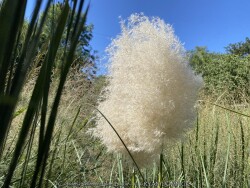

***Description for this plant available with future update!*** Cortaderia selloana 'Blue Bayou' is hardy to zone 6b.
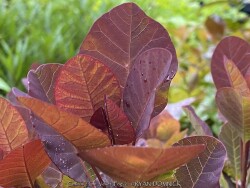

>>>>>In the words of breeder Tim Wood - "It's got more smoke than a KISS concert!" (Cotinus 'The Velvet Fog') Very large pink plumes develop in mid-summer, covering the waxy blue-green foliage. It's a stunning color combination. The Velvet Fog smokebush (Cotinus 'The Velvet Fog') was selected for its outstanding flower production as well as its dense growth, providing a lusher look than conventional cotinus. Pruning will rarely be required but may be done in spring. It isn't technically the flowers that create the hazy, smoke-like effect this plant is so loved for - it's the seed pods that form after the flowers have faded. In Eastern Kansas, this cultivar performs WELL with just about everything nature has to challenge it! Heat and drought are preferred and need hot microclimate. Cold tolerance is no problem. Some leaf disease appears by late season from excessive rains and high humidity sometimes causing early defoliation. An important note about pruning: Do not attempt to rejuvinate an older tree/shrub in early fall. This will trick it into growing back rapidly to recover and them WHAM!.Arctic cold blast arrives killing any new growth not hardened off. This double sapps the tree for nutrients usually resulting in death by spring. All Proven Winners® plants are legally propagated, healthy and vigorous, true to name, and tagged with color pictures and growing information.
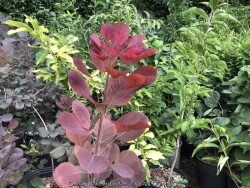

>>>>>A feast for the eyes from spring through autumn! Winecraft Black® Smoketrtee (Cotinus 'Winecraft Black') is the first Proven Winners smokebush, so you know it must be special. In spring, round leaves emerge rich purple but as summer's heat comes on, they turn a deep near-black tone and finally light up in an array of reds and oranges in fall. In early summer, large, soft panicles of bloom appear that become the misty "smoke" that makes this such a popular landscape plant. Unlike other smokebush, it naturally has a rounded, dwarf habit which means that finally, every landscape has room for this unique plant. Top three reasons to grow Winecraft Black smokebush: 1.Color and interest from spring through frost. 2.No pruning or special maintenance required. 3.Dwarf habit makes it easy to use with any sized home or yard. Uses Notes: Smokebush makes a striking specimen, but is also effective as a low hedge or mass planting. Maintenance Notes: Winecraft Black smokebush is very easy to care for and requires little to nothing in the way of regular maintenance. Plant in full sun for best color and flowering. Pruning will rarely be required but may be done in spring. It isn't technically the flowers that create the hazy, smoke-like effect this plant is so loved for - it's the seed pods that form after the flowers have faded. In Eastern Kansas, this cultivar performs WELL with just about everything nature has to challenge it! Heat and drought are preferred and need hot microclimate. Cold tolerance is no problem. Some leaf disease appears by late season from excessive rains and high humidity sometimes causing early defoliation. An important note about pruning: Do not attempt to rejuvinate an older tree/shrub in early fall. This will trick it into growing back rapidly to recover and them WHAM!.Arctic cold blast arrives killing any new growth not hardened off. This double sapps the tree for nutrients usually resulting in death by spring. All Proven Winners® plants are legally propagated, healthy and vigorous, true to name, and tagged with color pictures and growing information.
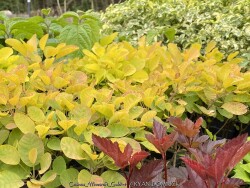

>>>>>A beaming beacon for the landscape. Bold, bright, and beautiful: that's Winecraft Goldtm Smokebush (). Round, waxy leaves emerge a sunny orange, soon take on a golden hue, then mature to a cheerful chartreuse for the season. In early summer, cloud-like green flower clusters cover the plant, and these turn into the pink "smoke" plumes that earn the plant its name. Naturally grows with a dense, oval shape that's ideal for adding a spot of bright color to partially shaded or sunny areas. Top reasons to grow Winecraft Gold smokebush: 1. bright golden foliage, 2. memorable smoke-like seedheads in summer, 3. smaller and more dense than conventional smokebush. Uses Notes: Makes a lovely specimen or addition to perennial gardens and flower borders. Maintenance Notes: It's best to avoid pruning smokebush regularly, though you may selectively remove branches to attain the shape you desire. It's quite versatile and easy to grow, but do note that this golden selection is a bit less cold tolerant than other smokebush. In Eastern Kansas, this cultivar performs WELL with just about everything nature has to challenge it! Heat and drought are preferred and need hot microclimate. Cold tolerance is no problem. Some leaf disease appears by late season from excessive rains and high humidity sometimes causing early defoliation. An important note about pruning: Do not attempt to rejuvinate an older tree/shrub in early fall. This will trick it into growing back rapidly to recover and them WHAM!.Arctic cold blast arrives killing any new growth not hardened off. This double sapps the tree for nutrients usually resulting in death by spring. All Proven Winners® plants are legally propagated, healthy and vigorous, true to name, and tagged with color pictures and growing information.
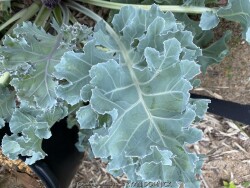



***Description for this plant available with future update!***